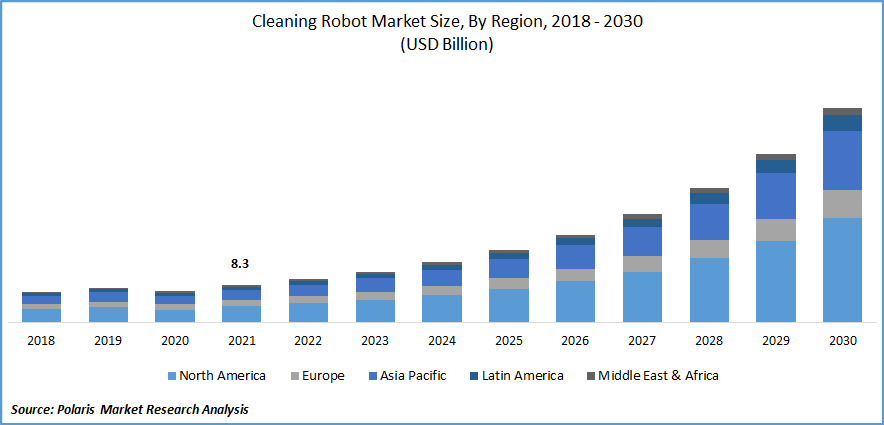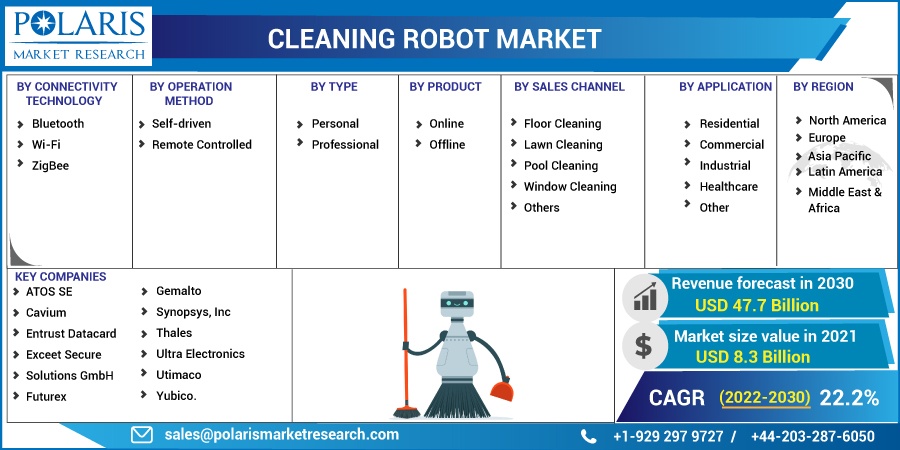
Cleaning Robot Market Share, Size, Trends, Industry Analysis Report
By Connectivity Technology; By Operation Mode (Self-Driven, Remote Controlled); By Type; By Product; By Sales Channel; By Application; By Region; Segment Forecast, 2022 - 2030
- Published Date:Oct-2022
- Pages: 118
- Format: PDF
- Report ID: PM2716
- Base Year: 2021
- Historical Data: 2018-2020
Report Outlook
The cleaning robot market was valued at USD 8.3 billion in 2021 and is expected to grow at a CAGR of 22.2% during the forecast period. The growing use of cleaning robots in homes, along with the emergence of automation and artificial intelligence in household uses, has led to an increase in demand for cleaning robots.

Know more about this report: Request for sample pages
Cleaning is done on a large scale in the commercial and industrial sectors, and cleaning robots help to save labor costs, which in turn assists the companies involved in these sectors in reducing operation costs, ultimately propelling the market's growth.
These robots replace manual labor by saving both time and cost. Also, these robots are increasingly used in the steel-cleaning and blasting of vessels, cleaning storage tanks in the oil and gas industry, and cleaning metal structures in industrial plants, which is likely to stimulate the market's growth.
However, the high price tag attached to cleaning robots is limiting the market's growth. A cleaning robot is more expensive than a conventional vacuum cleaner. Fewer people can afford it.
The Covid-19 pandemic's emergence positively influenced the demand for cleaning robots. The International Federation of Robotics reports that when cleanliness standards increased in response to the worldwide crisis, the utilization of professional cleaning robots surged by 92%. To maintain hygiene, more than 50 service robot manufacturers produced disinfection robots that used UV light and cleaning agents. Even after the pandemic, there is great potential for disinfection robots in healthcare facilities.
 Know more about this report: Request for sample pages
Know more about this report: Request for sample pages
Industry Dynamics
Growth Drivers
Robotic cleaning, when combined with data reporting technology, helps fleet managers to make operation easier and help to track and monitor the cleaning performance. This technology helps improve efficiency and operating time, reduce errors and identify areas of improvement. Such factors are expected to boost the market’s growth.
Rising innovations in the field of robotics for cleaning purposes are anticipated to accelerate the market’s growth. For instance, in 2021, a French company Poralu Marine launched the Serial Cleaner product line set of 4 robotic cleaners to clean and depollute coastlines, beaches, and oceans. One of them was BeBot, for cleaning beach.
The demand for cleaning robots that can speed up household cleaning has increased as the number of working men and women has increased in emerging economies. The use of these robots in homes is growing due to the Internet of Things and Home Area Networks (HAN) technologies.
Due to the growing use of barcodes and Radio Frequency Identification (RFID) technology for localization and self-positioning, these systems are becoming more popular in commercial applications.
Report Segmentation
The market is primarily segmented based on connectivity technology, operation method, type, product, sales channel, application, and region.
|
By Connectivity Technology |
By Operation Method |
By Type |
By Product |
By Sales Channel |
By Application |
By Region |
|
|
|
|
|
|
|
Know more about this report: Request for sample pages
A Bluetooth Segment is Expected to Account for the Largest Market Share in 2021
Bluetooth connectivity technology robot is expected to witness the most significant market revenue during the forecast period owing to its feasibility of implementing Bluetooth communication between smartphones and the cleaning device. This robot is efficient as it works without network disruption and is operated anywhere through smartphones. These factors are expected to propel the segment’s growth.
Self-Driven Segment Accounted for the Largest Market Share in 2021
Self-driven operation method acquired the largest market revenue in 2021 due to the development of technologies such as deep learning, artificial intelligence, and natural language processing to improve the performance of self-driven robots.
The market for self-driving robots is being driven by consumers' increasing preference for automated devices with high precision, energy efficiency, agility, and speech recognition. These robots have high-functioning and user-friendly consoles that enhance the user experience.
Personal Type Acquired the Largest Market Share in 2021
The personal type acquired the most significant share in 2021 due to increased consumer disposable income and higher living standards. The availability of sophisticated robotic vacuum cleaners with growing trends in smart home technology is anticipated to accelerate the market’s growth.
Furthermore, the ability to easily control personal cleaning robots using smartphones and remotes significantly contributes to the segment’s growth.
Floor-Cleaning Robots Accounted for a Significant Market Share in 2021
The floor cleaning robots segment accounted for the most considerable market revenue in 2021. The growing adoption of AI technology in cleaning robots for commercial applications and emerging urban middle-class households in developing countries would present new business opportunities for market participants. The vocal interaction capabilities that Amazon and Google have enabled for the robots have helped to increase their controllability.
The major players' increased focus on developing floor-cleaning robots is expected to propel the segment's growth. For instance, in 2022, iRobot introduced a brand-new robot platform called iRobot Genius Home Intelligence which is supposed to offer users a higher degree of customization and control over their cleaning products.
Online Segment is Expected to Account the Largest Market Share
The online segment is anticipated to account most significant market revenue due to the development of e-commerce, which has increased demand for robotic vacuums. The e-commerce industry is expanding dramatically in India, China, and South Korea, improving the market outlook. Additionally, alluring deals and discounts from online retailers like Walmart and eBay on robots are expected to fuel the market's growth.
Residential Segment is Expected to Witness Highest Growth Rate
The residential segment is anticipated to grow at the highest rate during the forecast period as employing domestic staff is too expensive. Cleaning duties like mopping and cleaning are carried out by cleaning robots in residential applications. It can efficiently complete the cleaning task in these circumstances. Some of them are also equipped with security features that notify the owner of an intrusion or a fire. The market is expanding due to rising product advancements for residential cleaning robots.
Furthermore, the rising demand for pet hair cleaning and grooming is expected to increase the demand for cleaning robots. It independently travels around and picks up the pet hairs so the owners can spend more time with their pets.
Asia-Pacific Dominated the Regional Market
Asia-Pacific dominated the regional market due to the increasing usage of robot vacuum cleaners for household applications, the emergence of international players, and the proliferation of cleaning robots for professional services in developing countries such as India, China, and South Korea.
North America is expected to grow fastest during the forecast period due to increasing awareness of advanced cleaning technologies and the widespread of cleaning robots for residential use in countries such as the US and Canada.
Competitive Insight
Some of the major players operating in the global market include Ecovacs Robotics, Inc., ILIFE Robotics Technology, iRobot Corporation, LG Electronics, Maytronics, Milagrow Business & Knowledge Solutions (Pvt.) Limited, Neato Robotics, Inc, Nilfisk Group, Pentair plc., and Samsung Electronics Co., Ltd.
Recent developments
- In January 2021, Samsung Electronics introduced JetBot 90 AI+, an innovative new home appliance that can help automate daily tasks.
- In June 2020, LG Electronics signed a contract with Miele & Cie. KG, which allows the latter to use the patent covering the robot vacuum cleaner technology.
Cleaning Robot Market Report Scope
|
Report Attributes |
Details |
|
Market size value in 2022 |
USD 9.62 billion |
|
Revenue forecast in 2030 |
USD 47.71 billion |
|
CAGR |
22.2 % from 2022 – 2030 |
|
Base year |
2021 |
|
Historical data |
2018 – 2020 |
|
Forecast period |
2022 – 2030 |
|
Quantitative units |
Revenue in USD billion and CAGR from 2022 to 2030 |
|
Segments Covered |
By Connectivity Technology, By Operation Method, By Type, By Product, By Sales Channel, By Application, By Region |
|
Regional scope |
North America, Europe, Asia Pacific, Latin America, Middle East & Africa |
|
Key Companies |
ATOS SE, Cavium, Entrust Datacard, Exceet Secure Solutions GmbH, Futurex, Gemalto, Synopsys, Inc, Thales, Ultra Electronics, Utimaco, Yubico. |
